I truly adore this quote and if one of your New Year’s resolutions is to travel more, you are in luck!
We’ve covered some fabulous getaways over the last couple years, Glamorous Getaways to be exact, that are perfect for food and wine lovers. From the charming L’Auberge Carmel in Carmel, California to the pet-friendly Park on Main Hotel in Highlands, North Carolina, grab a glass of wine and have fun planning your itinerary while perusing these wonderful options:
1.) L’Auberge Carmel – Carmel, California

2.) The Cloister at Sea Island – Sea Island, Georgia

3.) The (Pet-friendly) Park on Main – Highlands, North Carolina

4.) The Epicurean Hotel – Tampa, Florida

5.) The Inn on Fifth – Naples, Florida

Be sure to send us a virtual postcard by using #Glamorous Getaways on social media! What are some of your favorite food and wine related travel destinations? I’d love to hear about them in the Comments section below.
Bon voyage,
![]()
The post 5 Glamorous Getaways for Food & Wine Lovers appeared first on The Glamorous Gourmet.
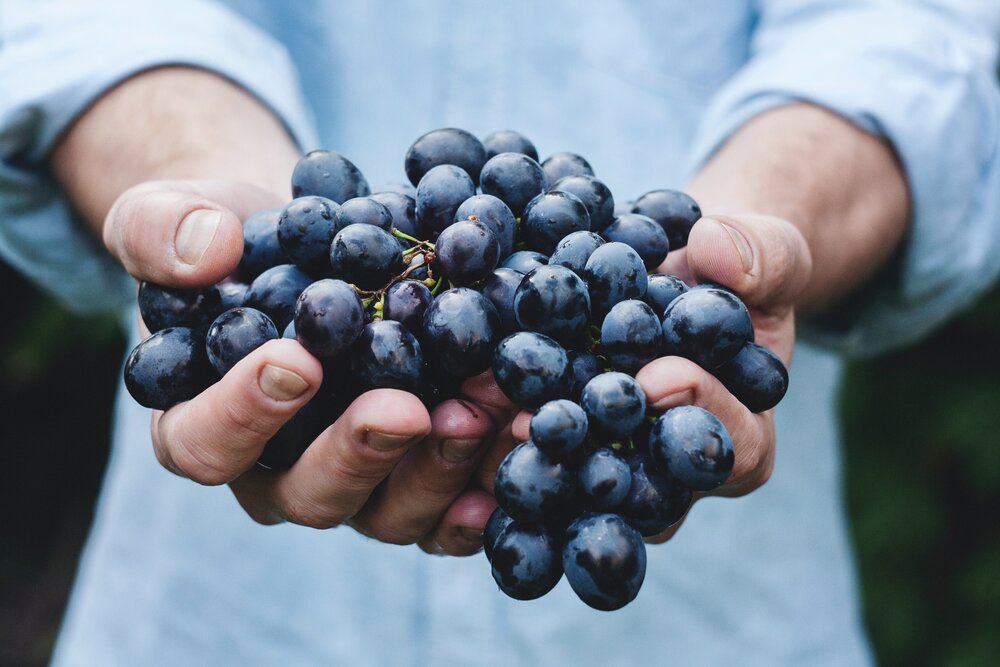
Fall and Winter are prime "red wine" seasons and the topic of tannins is certainly a hot one this time of year. For that reason, “tannins” is our official Wine Word of the Week. But if you think you don't know what "tannins" are, chances are good that if you're reading this, you've encountered them before - just ask yourselves these simple questions:
Have you ever taken a sip of red wine and felt a drying sensation in your mouth?
Have you ever woken up with a throbbing headache after a night of drinking red wine?
Have you ever enjoyed an aged red wine that was deliciously smooth and elegant?
If you've experienced any of the above, then you've experienced tannins, my wine loving friend! But just what the heck ARE they?
Tannins are naturally occurring compounds that play an important role in a wine's structure and directly affect its color, texture and aging ability. They are found in a host of plant species as well, and their astringent, bitter taste is intended to discourage predators and insects from consuming them. Similarly, tannins in wine are generally perceived as a drying, leathery sensation which is considered desirable by many wine lovers. This astringency acts as a preservative for wine, allowing it to age slowly with grace and not turn to vinegar.
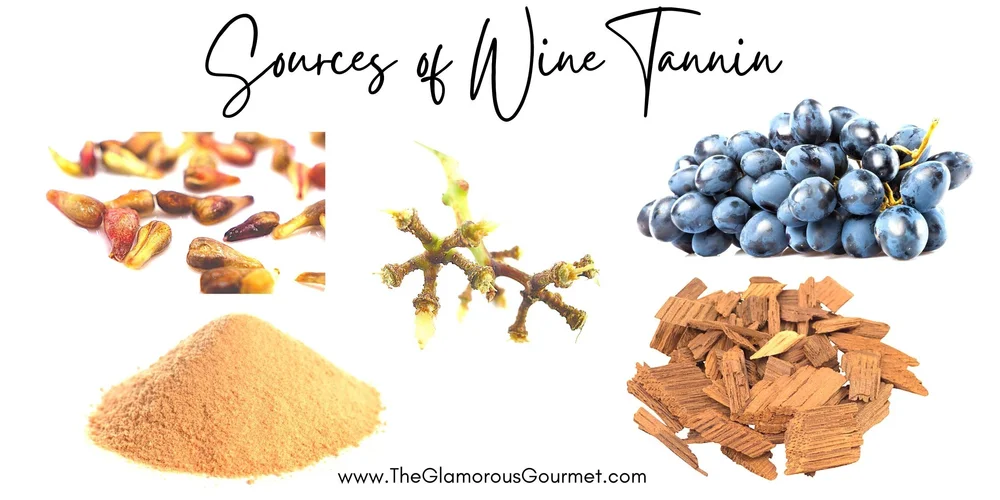
Depending on the type and age of a wine, its tannins can be described as velvety, firm, ripe, chewy, tight, dusty or round. In older wines, the tannins often precipitate out of solution to some degree and collect at the bottom of the wine bottle in the form of harmless sediment.
Wines acquire tannins through contact with grape skins, seeds and stems as well as the oak barrels the wine is aged in. For that reason, tannins are much more prevalent in red wine since the juice remains in contact with the grape skins for a period of time in order to obtain its color. Red wines are usually aged in oak barrels, another source of tannins for red wines. Also, the deeper the color of the red wine, the more tannins it contains, so a Cabernet Sauvignon will most likely have more tannins than a Pinot Noir.
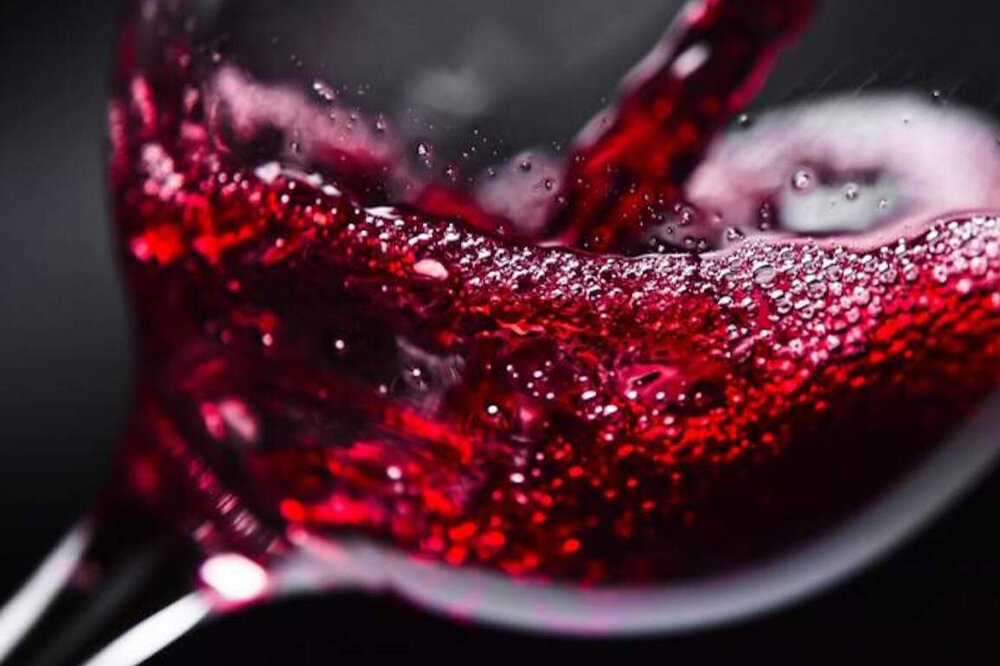
As far as food and wine pairing goes, protein actually mitigates tannins. Therefore, foods that are high in protein, like a juicy New York Strip Steak, pair remarkably well with tannic wines. In addition to Cabernet Sauvignon, the three most tannic grape varieties are Nebbiolo, Syrah and Tannat.
While some studies have shown tannins have beneficial effects on cardiovascular health, some believe it is the chemical compound that wreaks havoc on migraine sufferers. So, if you experience migraine headaches after drinking red wine, it's NOT the sulfites, my friend! White wine has approximately twice the sulfites as red wine and true sulfite allergies generally manifest as breathing issues, not headaches. So if you've got a tendency to get migraines, you may want to steer clear of high tannin red wines and opt for those with lower levels and see if it reduces their frequency and/or duration (for more information on this, please click here).
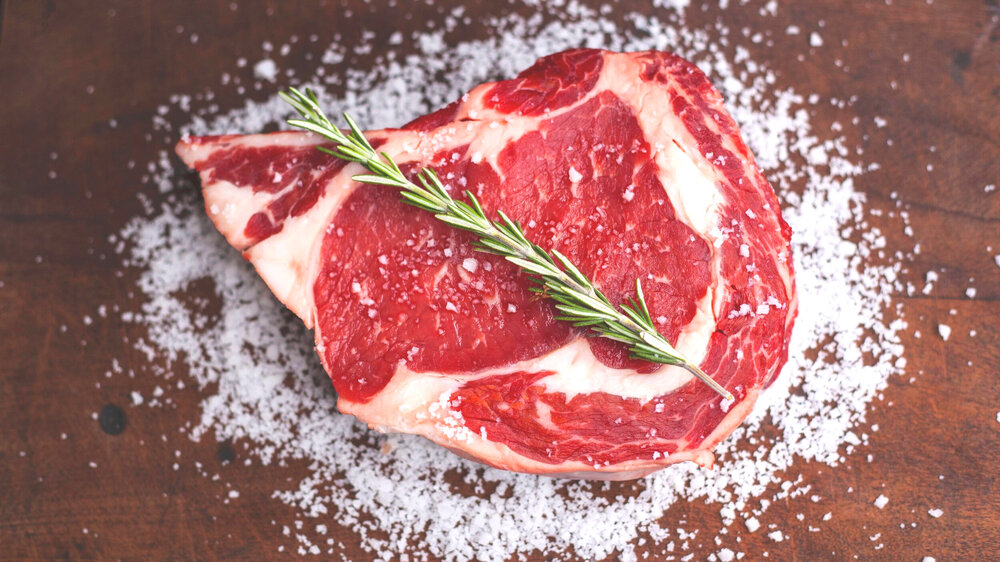
I hope you enjoyed this Wine Word of the Week and if you have any “wine words” you’d like to know more about, please share them in the Comments section below and I’ll be sure to get to them. To see previous installments of this segment, please click here and, as always, thanks for reading!
Winter is prime “red wine” season and the topic of tannins is a hot one this time of year. For that reason, it’s our official Wine Word of the Week. But if you think you don’t know what “tannins” are, chances are good that if you’re reading this, you’ve encountered them before:
If you’ve experienced any of the above, then you’ve experienced tannins, my wine loving friends! But just what the heck ARE they?

Tannins are naturally occurring compounds which play an important role in a wine’s structure and directly affect its color, texture and aging ability. They are found in a host of plant species as well, and their astringent, bitter taste is intended to discourage predators and insects from consuming them. Similarly, tannins in wine are generally perceived as a drying, leathery sensation which is considered desirable by many wine lovers. This astringency acts as a preservative for wine, allowing it to age slowly with grace and not turn to vinegar.
Depending on the type and age of a wine, its tannins can be described as velvety, firm, ripe, chewy, tight, dusty or round. In older wines, the tannins often precipitate out of solution to some degree and collect at the bottom of the wine bottle in the form of harmless sediment.

Wines acquire tannins through contact with grape skins, seeds and stems as well as charred oak barrels the wine is aged in. For that reason, they are much more prevalent in red wine which remains in contact with its skins in order to obtain its color and is usually aged in oak barrels. Also, the deeper the color of the red wine, the more tannins it contains, so a Cabernet Sauvignon will most likely have more tannins than a Pinot Noir.
As far as food and wine pairing goes, protein actually mitigates tannins. Therefore, foods that are high in protein, like a juicy New York Strip Steak, pair remarkably well with high tannin wines like Cabernet Sauvignon. In addition to Cabernet Sauvignon, the three most tannic grape varieties are Nebbiolo, Syrah and Tannat.

While some studies have shown tannins have beneficial effects on cardiovascular health, some believe it is the chemical compound that wreaks havoc on migraine sufferers. So, if you experience migraine headaches after drinking red wine, it’s NOT the sulfites, my friend! White wine has approximately twice the sulfites as red wine and true sulfite allergies generally manifest as breathing issues, not headaches. So if you’ve got a tendency to get migraines, you may want to steer clear of high tannin red wines and opt for those with lower levels and see if it reduces their frequency and/or duration (for more information on this, please click here).
I hope you enjoyed our latest Wine Word of the Week and if you have any “wine words” you’d like to learn more about, please feel free to share them in the Comments section below. To see previous installments of this segment, please click here and, as always, thanks for reading!
Cheers,
![]()
The post Wine Word of the Week: “Tannins” appeared first on The Glamorous Gourmet.
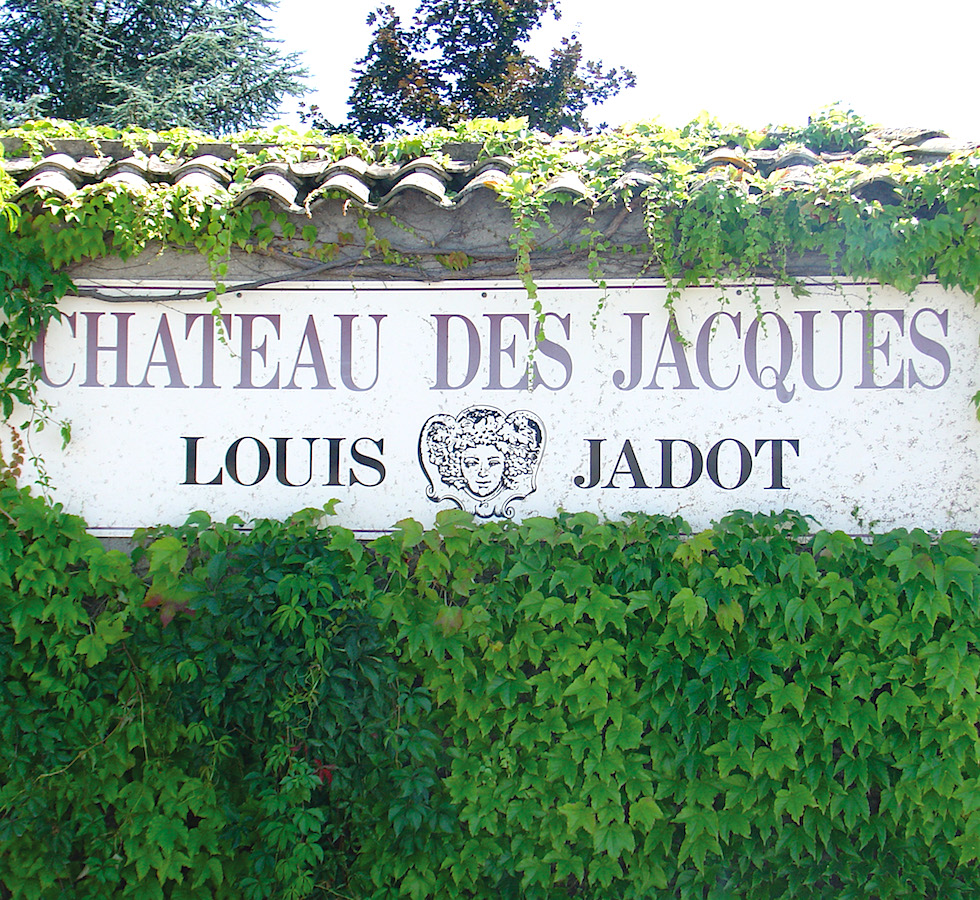
wow-jadot-chateau-des-jacques-sign
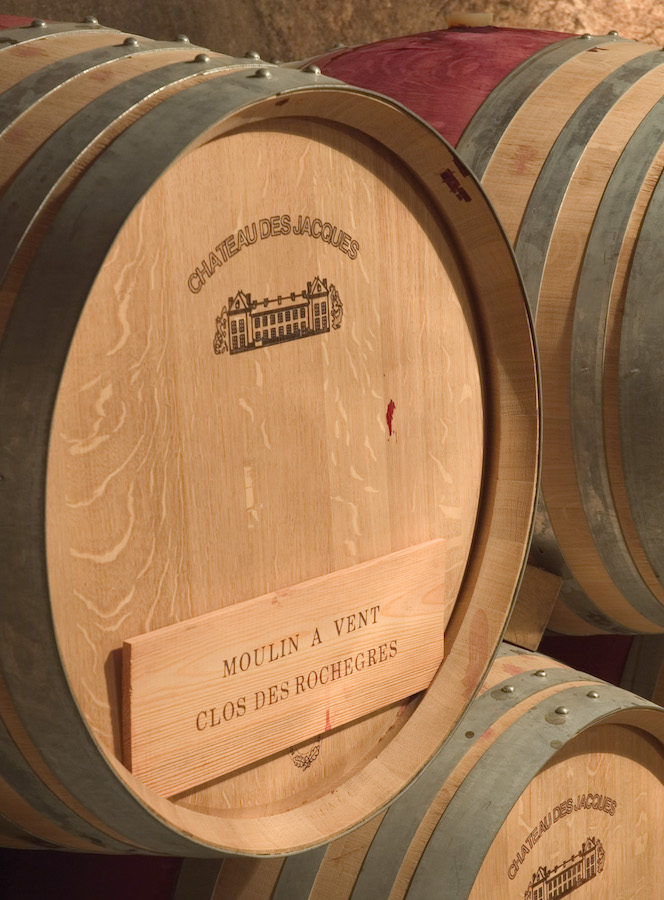
wow-jadot-chateau-des-jacques-barrels
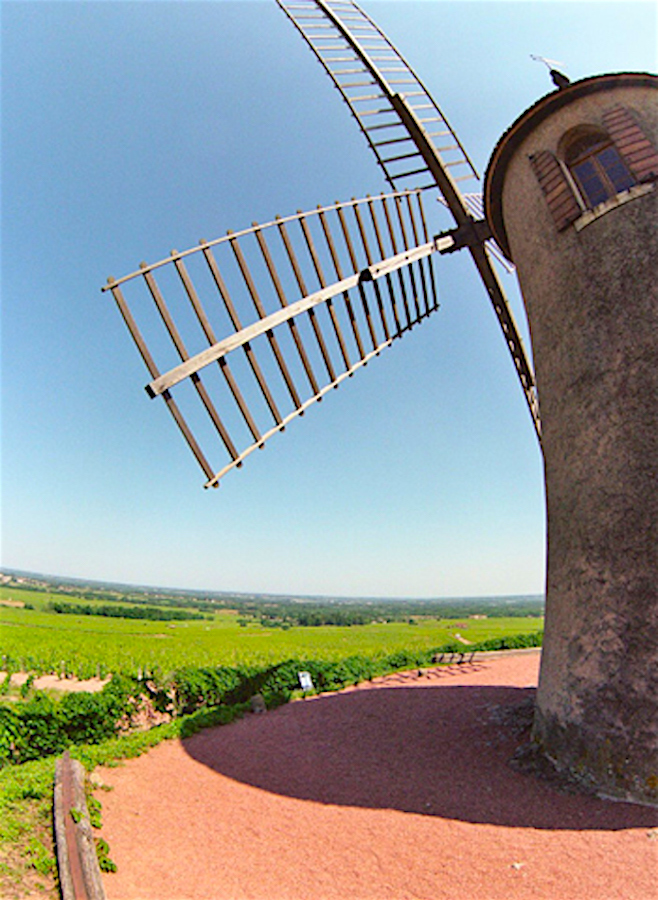
wow-jadot-chateau-des-jacques-moulin-a-vent-windmill

wow-jadot-chateau-des-jacques-winemaker
Winter is prime time for red wine and one wine I get oodles of questions about is Beaujolais. With the release of Beaujolais Nouveau on the third Thursday in November, like clockwork, it's easy for consumers to be seduced by all the advertising fanfare. Especially for a wine that's under $10 a bottle! But, you know what they say, if something seems too good to be true...it usually is.Unfortunately, Beaujolais Nouveau is essentially mass produced, poorly made wine that has marred the reputation of the region over the years. The upside to this situation however is, despite the jammy, insipid Nouveau wines, there are actually MANY fabulous Beaujolais wines worth exploring!Located in the southernmost part of Burgundy, Beaujolais also produces charming, easy-drinking red wines from the Gamay grape. This thin-skinned grape variety produces wines with minimal tannins capable of displaying a variety of aromas and flavors including cherry, raspberry,blackberry, violet and peony, which are usually accentuated by black pepper, herbs or spice. So how can you find these special wines and avoid the plonk? Please scroll down, my wine loving friends, for all the deets!The key to exploring and ultimately enjoying Beaujolais is actually quite simple: look for the name of one of the region's 10 crus on a wine label. A "cru" is a specific vineyard site within the Beaujolais appellation known for producing wines which express characteristics unique to their region, a quality known as terroir. In Beaujolais, the crus include Morgon, Moulin-a-Vent, Fleurie, Regnie, Brouilly, Cote de Brouilly, Chiroubles, Juliénas, Chénas and Saint-Amour. Seeing one of these names on a label usually ensures you're getting a quality wine.Which leads me to this week's featured wine, the 2011 Louis Jadot Château des Jacques Moulin-à-Vent ($20). This wonderful wine demonstrates much of what's to love about Beaujolais. After opening it the other night, almost five years after bottling, we were pleased to find an utterly delicious, casually elegant and enjoyable wine. A true gem at the price point to be sure and I hope you take the time during red wine season to enjoy all Beaujolais has to offer as well! Who it's from: Maison Louis Jadot was founded in 1859 by Louis Henry Denis Jadot whose family settled in Beaune near the turn of the century. Maison Louis Jadot focuses on the purest expression of terroir through the medium of the vine. The historic Château des Jacques estate, located in the Moulin-à-Vent appellation, was widely considered one of the most prestigious estates in Beaujolais and was purchased by Louis Jadot in 1996. As a result, Jadot became the first Burgundy house to own a major Beaujolais vineyard. In 2001, Louis Jadot bought another vineyard in Morgon. In 2008, both vineyards were regrouped as the Château des Jacques Estates.Where it's From: This wine hails from the the village of Moulin-à-Vent (which translates as 'windmill' in English), between Fleurie and Chenas. The Moulin-à-Vent wines are referred to as the “King ofBeaujolais,” and widely considered to be the most Burgundian“Cru” of Beaujolais. Unlike other crus, Moulin-à-Vent wines are often fuller-bodied and more complex with ample tannin and structure which allows them to age longer. The pink granite and manganese-rich soils of Moulin-à-Vent also promote the growth of concentrated grapes on the region's Gamay vines, which produce more intensely flavored wines.This Wine by the (Geeky) Numbers:Grape Variety: 100% GamayAppellation: Moulin-à-VentABV: 13%Ageing: 10 months in French oak (30% new), 6 months in bottle.The Glamorous Gourmet's Tasting Note: This wine beckons from the glass with its beautiful bright ruby red color and enticing aromas of dark fruit, spice cake and lavender. On the palate, fleshy dark fruit predominates with flavors of ripe black cherry, blackberry and cassis balanced by supple tannins and a bright acidity. Even after five years in the bottle this dynamic wine could have definitely lasted another five!Pair it with: This versatile wine would make a perfect match with a variety of dishes ranging from our recently posted Lamb, Harissa and White Bean Soup with Turmeric Yogurt as well as our super popular Quick Coq au Vin and Rosemary Roasted Chicken with Mushrooms and Caramelized Onion!Suggested Retail Price:$20 - and while this vintage is no longer on the market, find the most recent year you can and enjoy either now...or in a few years!Bon appétit,
Winter is prime time for red wine and one wine I get oodles of questions about is Beaujolais. With the release of Beaujolais Nouveau on the third Thursday in November, like clockwork, it’s easy for consumers to be seduced by all the advertising fanfare. Especially for a wine that’s under $10 a bottle! But, you know what they say, if something seems too good to be true…it usually is.
Unfortunately, Beaujolais Nouveau is essentially mass produced, poorly made wine that has marred the reputation of the region over the years. The upside to this situation however is, despite the jammy, insipid Nouveau wines, there are actually MANY fabulous Beaujolais wines worth exploring!
Located in the southernmost part of Burgundy, Beaujolais also produces charming, easy-drinking red wines from the Gamay grape. This thin-skinned grape variety produces wines with minimal tannins capable of displaying a variety of aromas and flavors including cherry, raspberry, blackberry, violet and peony, which are usually accentuated by black pepper, herbs or spice. So how can you find these special wines and avoid the plonk? Please scroll down, my wine loving friends, for all the deets!

The key to exploring and ultimately enjoying Beaujolais is actually quite simple: look for the name of one of the region’s 10 crus on a wine label. A “cru” is a specific vineyard site within the Beaujolais appellation known for producing wines which express characteristics unique to their region, a quality known as terroir. In Beaujolais, the crus include Morgon, Moulin-a-Vent, Fleurie, Regnie, Brouilly, Cote de Brouilly, Chiroubles, Juliénas, Chénas and Saint-Amour. Seeing one of these names on a label usually ensures you’re getting a quality wine.
Which leads me to this week’s featured wine, the 2011 Louis Jadot Château des Jacques Moulin-à-Vent ($20). This wonderful wine demonstrates much of what’s to love about Beaujolais. After opening it the other night, almost five years after bottling, we were pleased to find an utterly delicious, casually elegant and enjoyable wine. A true gem at the price point to be sure and I hope you take the time during red wine season to enjoy all Beaujolais has to offer as well!

Who it’s from: Maison Louis Jadot was founded in 1859 by Louis Henry Denis Jadot whose family settled in Beaune near the turn of the century. Maison Louis Jadot focuses on the purest expression of terroir through the medium of the vine. The historic Château des Jacques estate, located in the Moulin-à-Vent appellation, was widely considered one of the most prestigious estates in Beaujolais and was purchased by Louis Jadot in 1996. As a result, Jadot became the first Burgundy house to own a major Beaujolais vineyard. In 2001, Louis Jadot bought another vineyard in Morgon. In 2008, both vineyards were regrouped as the Château des Jacques Estates.
Where it’s From: This wine hails from the the village of Moulin-à-Vent (which translates as ‘windmill’ in English), between Fleurie and Chenas. The Moulin-à-Vent wines are referred to as the “King of Beaujolais,” and widely considered to be the most Burgundian “Cru” of Beaujolais. Unlike other crus, Moulin-à-Vent wines are often fuller-bodied and more complex with ample tannin and structure which allows them to age longer. The pink granite and manganese-rich soils of Moulin-à-Vent also promote the growth of concentrated grapes on the region’s Gamay vines, which produce more intensely flavored wines.

This Wine by the (Geeky) Numbers:
Grape Variety: 100% Gamay
Appellation: Moulin-à-Vent
ABV: 13%
Ageing: 10 months in French oak (30% new), 6 months in bottle.
The Glamorous Gourmet’s Tasting Note: This wine beckons from the glass with its beautiful bright ruby red color and enticing aromas of dark fruit, spice cake and lavender. On the palate, fleshy dark fruit predominates with flavors of ripe black cherry, blackberry and cassis balanced by supple tannins and a bright acidity. Even after five years in the bottle this dynamic wine could have definitely lasted another five!

Château des Jacques Winemaker, Cyril Chirouze
Pair it with: This versatile wine would make a perfect match with a variety of dishes ranging from our recently posted Lamb, Harissa and White Bean Soup with Turmeric Yogurt as well as our super popular Quick Coq au Vin and Rosemary Roasted Chicken with Mushrooms and Caramelized Onion!
Suggested Retail Price: $20 – and while this vintage is no longer on the market, find the most recent year you can and enjoy either now…or in a few years!
Bon appétit,
![]()
The post Wine of the Week: 2011 Louis Jadot Château des Jacques Moulin-à-Vent, Beaujolais, France appeared first on The Glamorous Gourmet.

lamb-harissa-white-bean-soup-final-closeup
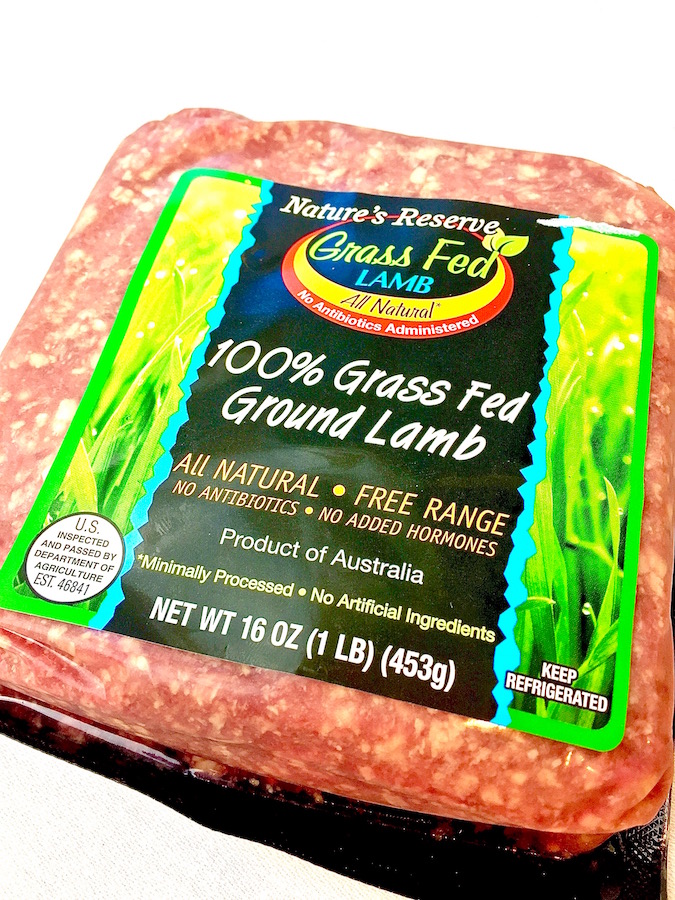
lamb-harissa-white-bean-soup-lamb
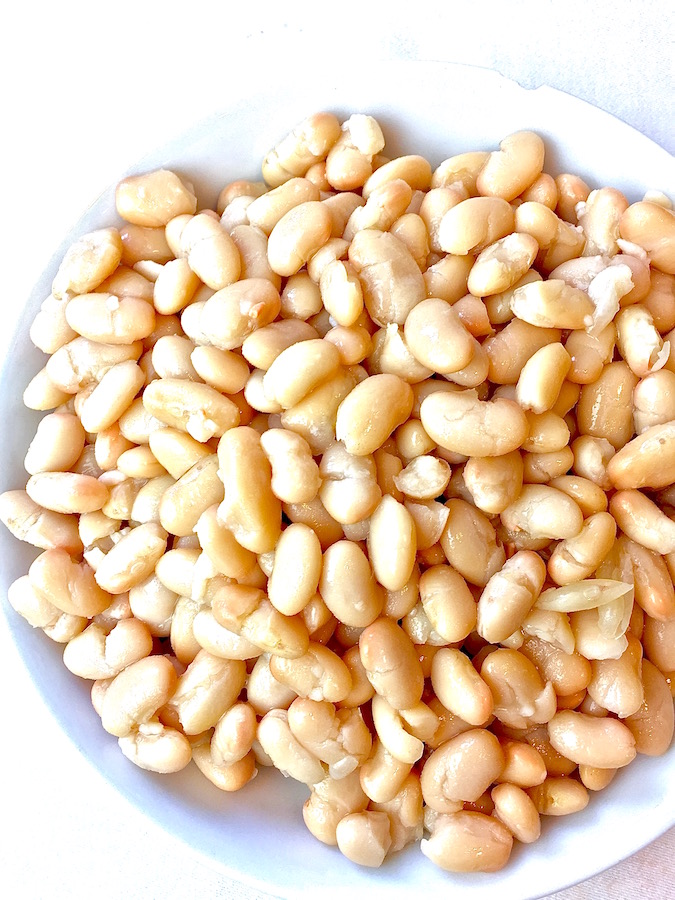
lamb-harissa-white-bean-soup-beans-dish
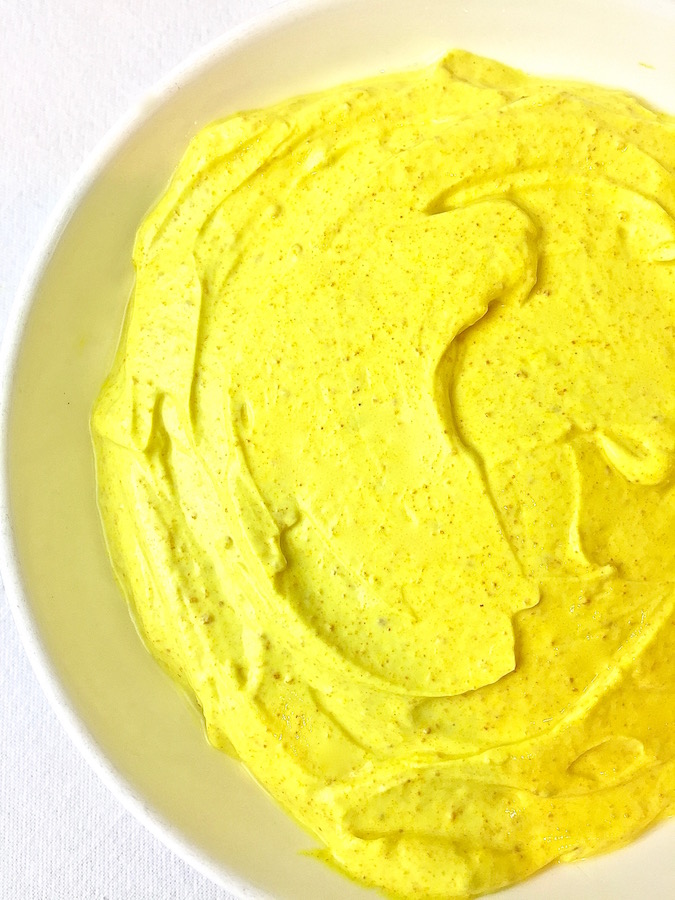
lamb-harissa-white-bean-soup-turmeric-yogurt
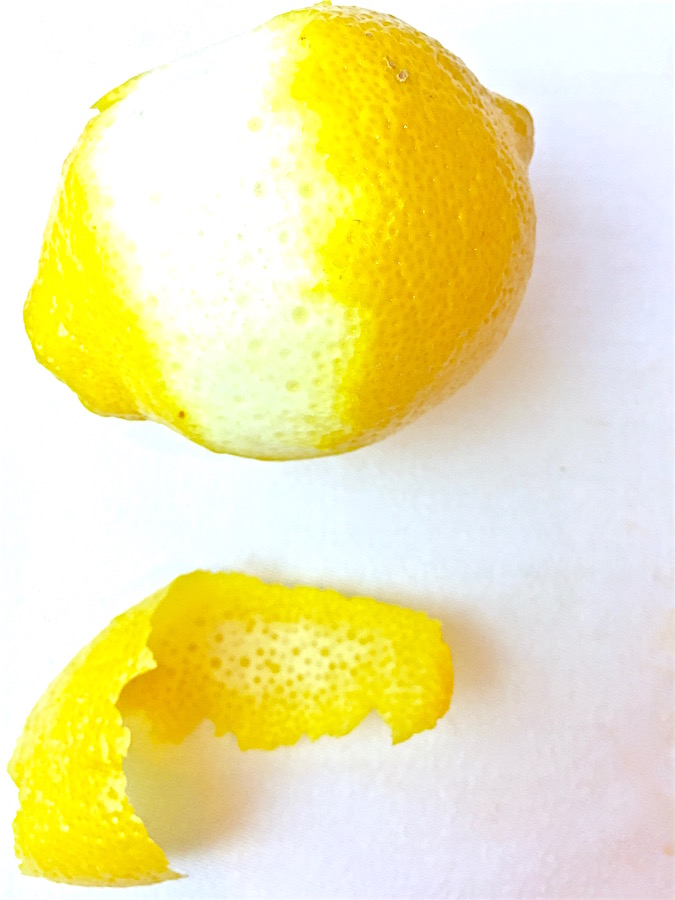
lamb-harissa-white-bean-soup-lemon
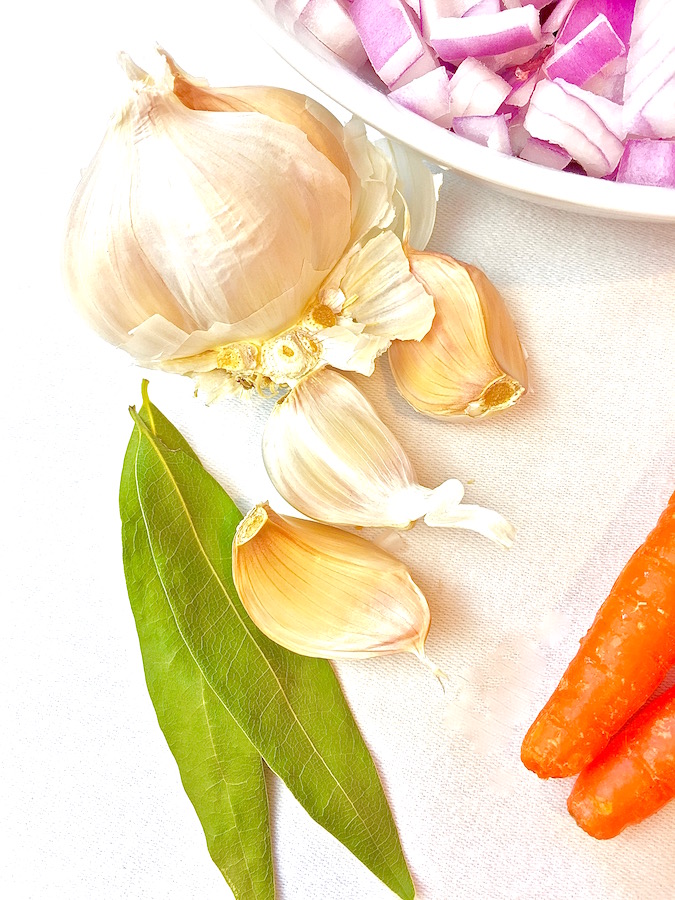
lamb-harissa-white-bean-soup-ingredients-2
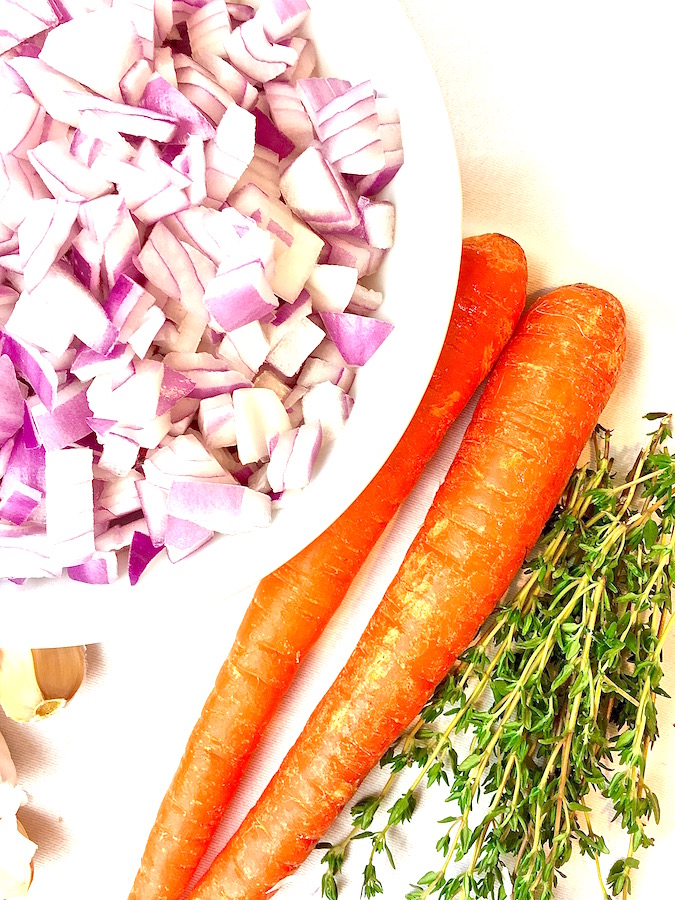
lamb-harissa-white-bean-soup-ingredients-1

lamb-harissa-white-bean-soup-pot-shot-2
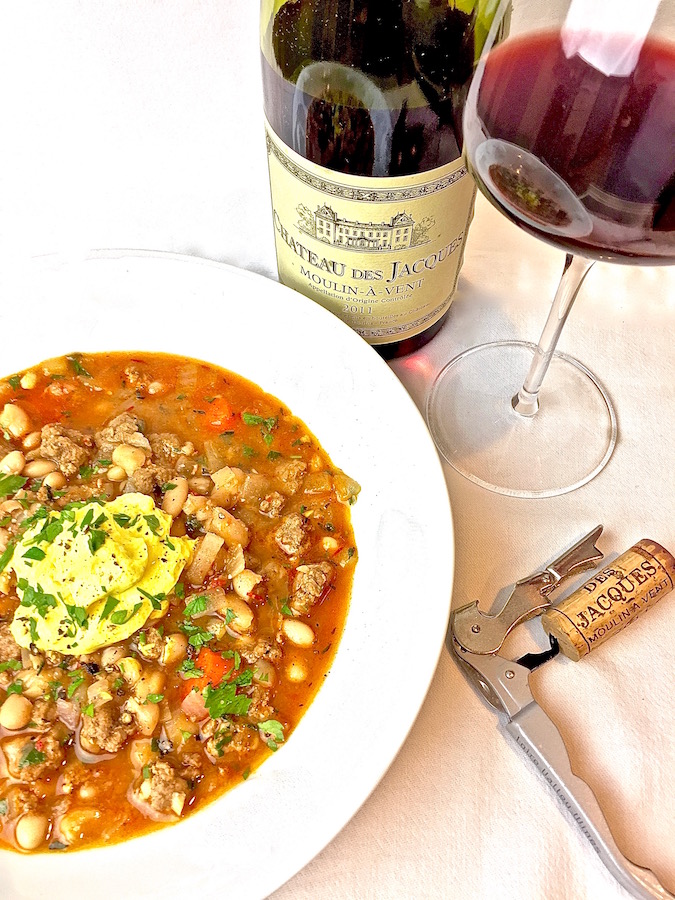
lamb-harissa-white-bean-soup-final-1
While our first recipe in this week of New Year's healthiness was the perfect snack to get you through your January indulgence withdrawals, this recipe for Lamb, Harissa & White Bean Soup with Turmeric Yogurt is the perfect healthy meal.Inspired by a vegetarian recipe I recently saw in Food & Wine Magazine that takes over 8 hours to make, I've reduced this recipe to under 2 hours (including prep!) without sacrificing one iota of flavor. I also glammed it up by adding some ground, grass-fed Australianlamb. Not baaaaaad, if you ask me. Apologies for the lamb humor.And while you could omit the lamb, I must say the succulent meat melds deliciously well with the flavors of the spicy harissa, creamy white beans and sweet Hungarian paprika. While I originally intended to freeze some of the soup for later consumption, the Hubs had other plans. It was so delicious it disappeared from my kitchen in record time!In addition to its fabulous flavor, this dish also contains some super trendy, healthy ingredients including (1) turmeric, (2) savory yogurt and (3) harissa.Native to southern Asia, turmeric has been used in both culinary and medicinal applications for thousands of years. With its earthy flavor and bright orange-yellow hue, it is a key ingredient in Indian, Iranian and Pakistani cuisine and also gives curries their hallmark golden hue. The health benefits of turmeric stem from an active compound called curcumin which is known to have powerful anti-inflammatory properties. It is especially beneficial for cardiovascularhealth, join pain and diabetes.Savory yogurt has also enjoyed a recent surge of popularity. This unsweetened yogurt offers the same nutritional benefits (i.e. calcium and protein) without the additional calories and sugars of fruit yogurts. Savory yogurts are also perfect for healthy add-ons such as chopped tomatoes, cucumbers and Kalamata olives or drizzled with extra virgin olive oil and topped with flaky sea salt. Unsweetened yogurt can also be used in place of sour cream...imagine the possibilities! As with many dairy products lately, whole fat varieties are being recommended over slimmed down versions (i.e. non-fat, reduced fat) which don't have as much staying power.Move over sriracha, harissa is the new spicy condiment in town! This North African hot chili pepper paste is essentially a blend of chili pepper, olive oil and garlic commonly used in Tunisian and Moroccan cuisine. It can also include coriander, cumin, mint and a variety of other ingredients. Use any harissa you have left over from this recipe to flavor dishes ranging from fried eggs to roasted chicken for a delightful kick of heat. It's metabolic boosting properties have even been touted by Dr. Oz! Also, for those of you doing the Paleo thang, harissa is "Paleo-approved" so feel free to get your spice on.Since Old World wines are especially waistline friendly and on our agenda for January, we enjoyed a delightful cruBeaujolais from Maison Louis Jadot with the Lamb, Harissa and White Bean Soup. The 2011 Chateau des Jacques Moulin-a-Vent, made from the Gamay grape, had lovely notes of blackberry, plum, minerals and cassis with supple tannins and a delightful finish.Since this dish is somewhat spicy, a light, fruity wine with friendly tannins is the best pairing. Bold tannins and hot, spicy foods tend to clash on the palate, creating a very unpleasant flavor situation. Another lighter red like Pinot Noir would also be a wonderful choice.I hope you enjoy this healthy and delicious recipe for Lamb, Harissa and White Bean SoupwithTurmeric Yogurt as much as we do! I'd love to hear your thoughts in the Comments section below. Stay tuned for more healthy, delicious goodness coming this week.Bon appétit,
"Lamb, Harissa & White Bean Soup with Turmeric Yogurt"
Recipe Type
:
Soup
Author:
Adapted from Food & Wine Magazine, Jan. 2017
Serves:
4-6
Pair this delicious dish with a light, fruity red wine such as a cru Beaujolais or Pinot Noir
Ingredients
1 1/2 lbs. ground lamb
3 Tablespoons butter
2 Tablespoons good olive oil
1 large red onion, finely chopped
5 garlic cloves, finely chopped
1/4 cup plus 3 Tablespoons spicy harissa, plus more for serving
3 Tablespoons tomato paste
1 teaspoon ground cumin
1 teaspoon sweet Hungarian paprika
4 cans white beans, drained & rinsed
3 thyme sprigs plus 2 teaspoons chopped fresh thyme leaves
2 bay leaves
3-inch strip of lemon zest plus 3 Tablespoons fresh lemon juice
2 teaspoons ground turmeric
1 1/2 cups full-fat Greek yogurt
1/2 cup roughly chopped, flat leaf, Italian parsley
Kosher salt & freshly ground black pepper
Instructions
In a large pot, heat 2 Tablespoons of the butter and olive oil. Add the onion and garlic and saute until soft, about 5 minutes. Add the ground lamb to the pot and saute until lamb is browned.
Stir in 1/4 cup of the harissa and the tomato paste and cook, stirring until fragrant, 1 minute. Stir in the cumin and paprika, then add 3 cups of water and bring soup to a simmer, scraping up browned bits on the bottom of the pot. Add the thyme sprigs, bay leaves, lemon zest and juice to the pot, stir well and simmer, covered, for 15 minutes.
While the soup simmers, in a small, non-stick skillet, melt the remaining Tablespoon of butter. Add the ground turmeric and cook over moderately low heat, stirring constantly until it dissolves, about 30 seconds. Transfer to a medium bowl and allow to cool slightly, about 5 minutes. Slowly stir in the Greek yogurt until smooth. Season to taste with salt.
To the simmering soup, add the drained, rinsed white beans to the pot and heat through, about 10 minutes. Just before serving, add the chopped thyme and parsley and remaining 3 Tablespoons of harissa. Season to taste with salt and pepper.
Serve the soup with turmeric yogurt and extra harissa on the side.
3.5.3226
While our first recipe in this week of New Year’s healthiness was the perfect snack to get you through your January indulgence withdrawals, this recipe for Lamb, Harissa & White Bean Soup with Turmeric Yogurt is the perfect healthy meal.

Inspired by a vegetarian recipe I recently saw in Food & Wine Magazine that takes over 8 hours to make, I’ve reduced this recipe to under 2 hours (including prep!) without sacrificing one iota of flavor. I also glammed it up by adding some ground, grass-fed Australian lamb. Not baaaaaad, if you ask me. Apologies for the lamb humor.
And while you could omit the lamb, I must say the succulent meat melds deliciously well with the flavors of the spicy harissa, creamy white beans and sweet Hungarian paprika. While I originally intended to freeze some of the soup for later consumption, the Hubs had other plans. It was so delicious it disappeared from my kitchen in record time!


In addition to its fabulous flavor, this dish also contains some super trendy, healthy ingredients including (1) turmeric, (2) savory yogurt and (3) harissa.
Native to southern Asia, turmeric has been used in both culinary and medicinal applications for thousands of years. With its earthy flavor and bright orange-yellow hue, it is a key ingredient in Indian, Iranian and Pakistani cuisine and also gives curries their hallmark golden hue. The health benefits of turmeric stem from an active compound called curcumin which is known to have powerful anti-inflammatory properties. It is especially beneficial for cardiovascular health, join pain and diabetes.
Savory yogurt has also enjoyed a recent surge of popularity. This unsweetened yogurt offers the same nutritional benefits (i.e. calcium and protein) without the additional calories and sugars of fruit yogurts. Savory yogurts are also perfect for healthy add-ons such as chopped tomatoes, cucumbers and Kalamata olives or drizzled with extra virgin olive oil and topped with flaky sea salt. Unsweetened yogurt can also be used in place of sour cream…imagine the possibilities! As with many dairy products lately, whole fat varieties are being recommended over slimmed down versions (i.e. non-fat, reduced fat) which don’t have as much staying power.


Move over sriracha, harissa is the new spicy condiment in town! This North African hot chili pepper paste is essentially a blend of chili pepper, olive oil and garlic commonly used in Tunisian and Moroccan cuisine. It can also include coriander, cumin, mint and a variety of other ingredients. Use any harissa you have left over from this recipe to flavor dishes ranging from fried eggs to roasted chicken for a delightful kick of heat. It’s metabolic boosting properties have even been touted by Dr. Oz! Also, for those of you doing the Paleo thang, harissa is “Paleo-approved” so feel free to get your spice on.


Since Old World wines are especially waistline friendly and on our agenda for January, we enjoyed a delightful cru Beaujolais from Maison Louis Jadot with the Lamb, Harissa and White Bean Soup. The 2011 Chateau des Jacques Moulin-a-Vent, made from the Gamay grape, had lovely notes of blackberry, plum, minerals and cassis with supple tannins and a delightful finish.
Since this dish is somewhat spicy, a light, fruity wine with friendly tannins is the best pairing. Bold tannins and hot, spicy foods tend to clash on the palate, creating a very unpleasant flavor situation. Another lighter red like Pinot Noir would also be a wonderful choice.


I hope you enjoy this healthy and delicious recipe for Lamb, Harissa and White Bean Soup with Turmeric Yogurt as much as we do! I’d love to hear your thoughts in the Comments section below. Stay tuned for more healthy, delicious goodness coming this week.
Bon appétit,
![]()
The post New Year, Healthier You Recipe #2: Lamb, Harissa & White Bean Soup with Turmeric Yogurt appeared first on The Glamorous Gourmet.